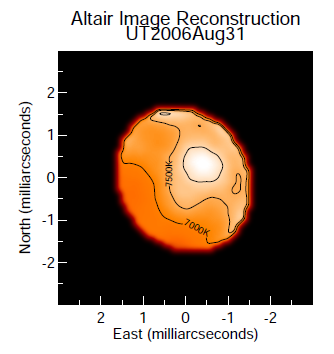This is super cool because it's really really hard to take a picture of the surface of a star. As prof. Monnier explained, the size of a star compared to the distance between stars is about one to 5 million, and so to be able to resolve the disk of a star, your telescope would have to be able to resolve about 0.000001 degrees, or a few milliarcseconds. That's equivalent to being able to see a penny from about five hundred kilometres. The size of the telescope needed resolve even the closest star in visible light would have to be at least 40 meters across, which is bigger than any telescope built to date. (So whenever you look at any star through a telescope, it looks like a point of light, and not a resolved disk, and so isn't much more interesting than looking at it with the naked eye.)
Fortunately, prof. Monnier and his group are able to image stars through the magic of interferometry! This is basically combining the light from many small telescopes to make it seem like one big telescope. This is fairly easy to do with radio waves, but considerably harder to do with shorter wavelengths, like visible light. However, on Mount Wilson, they've managed to do this with an array of infrared telescopes, and have taken the image of the surfaces of several stars. Here's a picture of Altair they took in 2007:

Now, you may notice that Altair is not uniform in colour (and thus in temperature). This is because the rotation of the star causes it to be more flattened along its axis of rotation, and bulges around the equator. This means that the surface at the equator of the star is further from its core, and is therefore cooler at the equator than at the poles. (This is really an over-simplification, but the idea is essentially right.) Monnier's group has found that for very rapidly rotating stars, the temperature gradient between the equator and the poles can be several thousands of degrees, and that's where the trouble begins.
Why would this be a problem, you may ask? Well, astronomers like to classify stars by their temperature, and when the difference in temperatures on the surface of a star is larger than the classification temperature range, this makes their lives very difficult. And knowing the actual temperature of a star is very important for, say, placing it on the Hertzsprung-Russell diagram:

Prof. Monnier also talked about his work in imaging the star Epsilon Aurigae. This is a very special object because every 27 years, it is eclipsed by something. It was postulated that there was some sort of compact object in a binary orbit with the star that has a large dusty disk, and whenever this disk would pass in front of the star, the star's light would be blocked. Sean Carroll wrote a really long blog entry about it a few months ago, so I won't go into too much detail. The really cool thing is that in 2009, Monnier's group was actually able to image this dusty disk passing in front of Epsilon Aurigae.

There were also a few other things that I can't remember off the top of my head right now, and obviously I didn't take notes because I was busy knitting. Observational astronomy and stellar astrophysics aren't really my thing, but when cool stuff like this is going on, it's hard not to get excited!
No comments:
Post a Comment